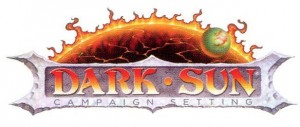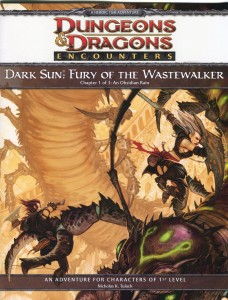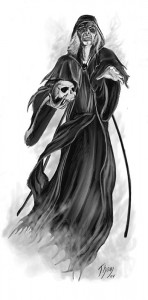Dark Sun is the hottest topic in D&D right now. We posted 10 Dark Sun articles here at Dungeon’s Master throughout the last month and promise to keep writing more on Athas and D&D Encounters season two. But that’s not all we covered in June. We still brought you plenty of player and DM resources as well as news from the D&D community. And just to let you know we haven’t forgotten about Eberron, we provided another installment in our ongoing Secrets of Eberron series. So whether you missed an article or two throughout June or you’ve only just stumbled upon our site, the Month in Review is a great way to get caught up on everything we ran in the past month. We’d also like to take this opportunity (as we do every month) to thank all of our readers for visiting Dungeon’s Master and for coming back again and again.
Tag: Dungeons and Dragons
Knowing when to heal during combat is an under appreciated ability in Dungeons & Dragons. Too many players think that their characters are invincible, able to take whatever the DM throws their way. This refusal by the players to accept the reality of the situation can be detrimental, not only to their PC, but also to the rest of the party. Refusing to heal in favour of a combat action is a calculated risk that every player is forced to make. The question is what is the right decisions to make? While hindsight is always 20/20 we’d like to think we are making the right choices for our PCs.
 The six pre-generated characters provided for D&D Encounters Dark Sun are so condensed that they only list the three or four skills each PC is trained in. So for everyone playing D&D Encounters season two, I’ve created skill cards for each character.
The six pre-generated characters provided for D&D Encounters Dark Sun are so condensed that they only list the three or four skills each PC is trained in. So for everyone playing D&D Encounters season two, I’ve created skill cards for each character.
I’ll admit that the character sheet cards Wizards provided look great, but other than the aesthetic quality, the cards are terrible. They provide the absolute bare minimum detail required to play the characters. Some might even argue that they don’t even contain that much.
I’ve been perusing the D&D Player’s Strategy Guide since I received it as a Father’s Day gift this past Sunday. My reading hasn’t been focused on building the best character, as I have already done that. Of course my best character may not be your best character and that’s ok, I forgive you your delusions.
One of the interesting sections in the Player’s Strategy Guide is the “How To” section that runs through page 62 – 81. The section covers everything from gaining the highest initiative, being the best healer and having the most hit points. What it doesn’t offer is how to build a character that can’t be killed. As a result here is my take on how to build a character that simply won’t die. Over the next couple of weeks we’ll run some variations on this theme of “How To”.
 What do you get when four PCs are attacked by goblins from high atop a rocky outcropping? One hell of a tough encounter. Week 3 was another grueling session for the players at my table. They eventually defeated all of the monsters, but the toll on their personal resources was costly. If they thought encounter 3 was tough, encounters 4 and 5 will be nearly impossible without a significant turn of events.
What do you get when four PCs are attacked by goblins from high atop a rocky outcropping? One hell of a tough encounter. Week 3 was another grueling session for the players at my table. They eventually defeated all of the monsters, but the toll on their personal resources was costly. If they thought encounter 3 was tough, encounters 4 and 5 will be nearly impossible without a significant turn of events.
There they were getting pelted from above when we took stock of party’s ranged attack options. Yuka, no ranged attacks. Phye, no ranged attacks. Shikirr, no ranged attacks. That left Barcan. The same Barcan with only 2 healing surges remaining. Barcan with the poorest defenses of all the pre-generated characters. After only 5 minutes we knew this was going to ugly.
5 Errors I’ve Made as DM
 DMs aren’t perfect. There I’ve said it. Any DM that claims he’s never made an error when running a game is lying. Even the best DMs make mistakes. Over the years I’ve made plenty of errors while playing D&D. I’ve found that the best thing to do in these situations is to try and learn from the experience. So today I’m going to share with you the 5 biggest and most egregious errors I’ve made as a DM. I think you’ll find that these are fairly common mistakes made by DMs across the board.
DMs aren’t perfect. There I’ve said it. Any DM that claims he’s never made an error when running a game is lying. Even the best DMs make mistakes. Over the years I’ve made plenty of errors while playing D&D. I’ve found that the best thing to do in these situations is to try and learn from the experience. So today I’m going to share with you the 5 biggest and most egregious errors I’ve made as a DM. I think you’ll find that these are fairly common mistakes made by DMs across the board.
The 4e Necromancer Has Been Announced
 One of the first articles published at Dungeon’s Master was our take on the Necromancer. Since that time we’ve produced a revised version of our heroic, paragon and epic tier take on the class, along with a general write up on different kinds of Necromancers. The Necromancer as envisioned by us was developed to address the fact that there were no Wizard specialists in 4e D&D. Along the way we’ve toyed with the idea of releasing a build of the class that is built on the Warlock and Cleric structure as well.
One of the first articles published at Dungeon’s Master was our take on the Necromancer. Since that time we’ve produced a revised version of our heroic, paragon and epic tier take on the class, along with a general write up on different kinds of Necromancers. The Necromancer as envisioned by us was developed to address the fact that there were no Wizard specialists in 4e D&D. Along the way we’ve toyed with the idea of releasing a build of the class that is built on the Warlock and Cleric structure as well.
Last week both the RPGA Character Creation Guide and the Living Forgotten Realms Character Creation Guide were updated. Both documents are effective tomorrow (June 22, 2010). This is the last update scheduled for either document until October. So if you play Living Forgotten Realms (LFR) or you’re planning on going to GenCon to play D&D then you should check out these updates. This is probably the largest single update since 4e was released. Here are the highlights.
It’s not something we like to think about, the death of the party, the end of the campaign. On occasion it is the right thing to do. Earlier this week we discussed Avoiding The Total Party Kill. This task falls jointly on the shoulders of the DM and the players. Embracing The Total Party Kill, falls on the players and is a decision that only they can make.
 This week I got a double dose of Dark Sun. I was on vacation last week, but before I left I made arrangements with 6 players to skip the first week and run encounters one and two back-to-back this week. After just two sessions of Fury of the Wastewalker I have to admit that I like this adventure a whole lot more than Halaster’s Lost Apprentice.
This week I got a double dose of Dark Sun. I was on vacation last week, but before I left I made arrangements with 6 players to skip the first week and run encounters one and two back-to-back this week. After just two sessions of Fury of the Wastewalker I have to admit that I like this adventure a whole lot more than Halaster’s Lost Apprentice.
D&D Encounters is a 15-part adventure from Wizards of the Coast and it’s played out one encounter each week over 15 weeks.